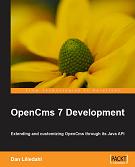OpenCms Application Overview
Before undertaking development, it will be helpful to understand the basic
design of OpenCms. OpenCms is structured as a typical J2EE web application
conforming to a 3-tier web application architecture:

A web server on the front-end tier services incoming requests. The requests are
passed through to an application server in the middle tier, where the OpenCms
application runs. The OpenCms application utilizes the database on the third
tier to read and store its content.
For production, using an array of web servers will typically distribute load to
the application server tier. A common choice is to use the Apache web server,
utilizing the mod_jk plug-in to distribute load. For development purposes,
using a web server is optional, and instead the application server container
may be accessed directly. Open Cms supports a wide variety of application
servers, including commercial servers such as IBM Websphere and BEA WebLogic.
It also supports open source servers such as Tomcat and JBoss. A popular choice
among developers is the Apache Tomcat server. We will be using the Apache
server for our development environment.
|

Book Excerpt: Overview
Chapter Contents
This excerpt from chapter 1 of
OpenCms 7 Development by Dan Liliedahl, is printed with
permission from Packt Publishing,
Copyright 2007.
|